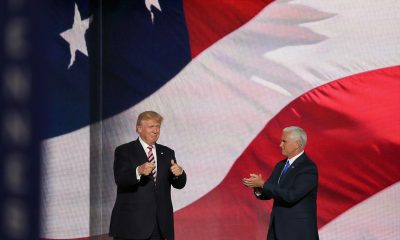Business
Public and private collaboration will be the norm as COVID-19 is contained
To reset the economy in 2020, trillions of dollars will be sent to state and local governmental entities. Congress is already drafting additional recovery bills that will send funding through state and local governmental jurisdictions. Projects of all types will be launched, and almost all will be collaborative initiatives between public and private entities.

State and local government contracting represented a multi-trillion dollar marketplace before the recent pandemic. That marketplace is now much larger … but its current size is insignificant compared to what it will be six months from now.
To combat the virus, trillions of dollars are being spent on services and equipment supplied by private-sector companies. Trillions more will be spent to get people back to work and ensure economic recovery when the virus is contained.
The $2.2 trillion recovery package passed by Congress is much larger than the $831 billion stimulus that was allocated to economic recovery after the Great Recession of 2008. But, the recent recovery bill is just the beginning of what Congress plans to spend.
Trillion would be needed to reset the economy
To reset the economy in 2020, trillions more will be sent to state and local governmental entities. Congress already is drafting additional recovery bills that will send funding through state and local governmental jurisdictions. Projects of all types will be launched, and almost all will be collaborative initiatives between public and private entities. That will be the fastest way to create jobs and combat a recession that is inevitable.
Companies that have never considered government contracting will, no doubt, be incentivized to reconsider that stance. And, experienced government contractors will see the competition increased exponentially. The action, opportunities, and immediate funding flows will be wrapped around government spending at the state and local levels of government.
When the President declared a national emergency, that action allowed the release of important emergency procurement tools for federal, state, and local government officials. It also immediately freed up $50 billion for public entities to spend.
Then, when major disaster designations were issued for numerous states, more procurement leniencies were allowed and additional funding became available to state and local government officials. Federal agencies began coordinating with other jurisdictions and the Federal Emergency Management Agency (FEMA), which coordinates and provides federal assistance for procurement, was ramped up to full capacity.
Supplies and services of every type are still needed. Demand has far exceeded supply. The pandemic is not yet contained.
The unfortunate realization by many companies and organizations capable of helping governmental entities was that they didn’t know how to get started. Companies throughout the U.S. were caught flatfooted. Because they had never contracted with the government in the past, they were simply not prepared to be a part of the recovery.
Too many firms that could have played a major role in recovery efforts were unable to overcome the challenges they faced. They didn’t know how or where to interact with public agencies. They had no contracting vehicles to offer. Most were not registered or certified to sell to the government and they didn’t know how to remedy that. Because of this, citizens in both the public and the private sector suffered.
How companies can get involved
Government contracting guidelines are hard to come by in emergency situations and most are difficult to understand. What follows is a quick, basic overview of a few government procurement basics because collaborative efforts between public and private sector parties will be America’s future. Every company should be preparing now to sell goods and services to the government.
There are many jurisdictions, and they all contract with private sector partners. Eventually, companies should check out procedures at every jurisdiction, but selling locally to the government is likely the most immediate way to start. It will be much less complicated.
At the federal level, there are basic procedures and different ways to find opportunities. The basics of getting started include the following:
- Become part of the General Services Administration (GSA) Schedules Program.
- Small firms can get assistance with the federal level through individual agencies’ Offices of Small and Disadvantaged Business Utilization.
- Another option is to become a subcontractor by working for another company that is pursuing a contract with the federal government.
- Register for notifications and search the Contract Opportunities Search Tool on beta.SAM.gov, which is now the official database of federal contracting opportunities.
FEMA also offers ways for the private sector to get involved
At the state level of government, most jurisdictions have sites for businesses to donate or sell supplies. Some of them include New York, Massachusetts, Washington, and Michigan.
Finally, at the local levels of government, almost all public entities have websites that set out procurement guidelines. And, most cities and counties have designated public officials to assist companies interested in selling to the government.
Funding will flow to states, cities, counties, school districts, universities, public hospitals, community colleges, health districts, transit agencies, and every other division of government. The following examples outline just a few areas where contracting will be rampant.
Hospital systems will receive $100 billion in funding for provisions and services. A 20 percent increase in Medicare payments for treating COVID patients also will help health care organizations.
Under the Coronavirus Aid, Relief, and Economic Security (CARES) Act, local and state government officials will receive $274 billion for COVID-19 use. More than $30 billion is allocated for education with $14 billion for colleges and universities and at least $13.5 billion for K-12 campuses.
Most school districts are feeding students, and instruction is being delivered online. The new bill allows for $8.8 billion for child nutrition programs.
The funding that is available now is but a start for government contractors. To get the country back to normal, public-private initiatives will be increased significantly. Congress has always depended on public and private initiatives after national disasters.
And, to ensure that businesses are viable and able to work with the government, Congress has provided various types of relief related to the pandemic. Businesses that have suffered because of shutdowns will find various types of relief in the most recent recovery program. The CARES Act sets out significant resources and funding in programs that will be administered by the U.S. Small Business Administration (SBA).
To ease even more strain on businesses around the country, the SBA has been given $350 billion that will be allocated through forgivable loans to businesses of all types. The funds are to be used for employee salaries and lease payments. The bill also sets aside $10 billion in grants for small businesses that need help covering short-term operating costs. The funding should begin flowing in a matter of weeks.
The future is clear – the pandemic will be contained and America will recover. Trends that have been set by COVID-19 will change many things and one very obvious change is that government contracting, which has always been the norm, will be even more robust. It will be a significant component of the country’s recovery and its continued vitality over the next decade.
—
(Featured image by Thomas Breher from Pixabay)
DISCLAIMER: This article was written by a third party contributor and does not reflect the opinion of Born2Invest, its management, staff or its associates. Please review our disclaimer for more information.
This article may include forward-looking statements. These forward-looking statements generally are identified by the words “believe,” “project,” “estimate,” “become,” “plan,” “will,” and similar expressions. These forward-looking statements involve known and unknown risks as well as uncertainties, including those discussed in the following cautionary statements and elsewhere in this article and on this site. Although the Company may believe that its expectations are based on reasonable assumptions, the actual results that the Company may achieve may differ materially from any forward-looking statements, which reflect the opinions of the management of the Company only as of the date hereof. Additionally, please make sure to read these important disclosures.

-

 Crypto1 week ago
Crypto1 week agoCaution Prevails as Bitcoin Nears All-Time High
-

 Africa4 days ago
Africa4 days agoBridging Africa’s Climate Finance Gap: A Roadmap for Green Transformation
-

 Biotech2 weeks ago
Biotech2 weeks agoEcnoglutide Shows Promise as Next-Generation Obesity Treatment
-

 Business2 days ago
Business2 days agoThe TopRanked.io Weekly Digest: What’s Hot in Affiliate Marketing [uMobix Affiliate Program Review]
























